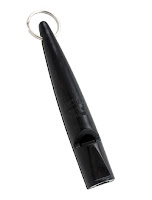
There is no single piece of training equipment as important as the simple six-foot lead.
That connection between you and your dog can be used for the most critical obedience exercises. A dog that will sit (and stay) when told to sit, and a dog that will come when called is a dog that can be trusted virtually anywhere to do almost anything a dog can do. Your six-foot lead will allow you to get to this high level of obedience.
Toss out the zip-lead and pick up a nice leather 3-quarter inch by six-footer with a solid brass buckle. The leash looks good and smells good. You can saddle soap it up when it gets dragged around. You and your dog are ready to go.
There are many books and how-to's on how to leash train your dog. What I will mention here are some simple but advanced exercises.
Heel. Work on heeling your dog. It looks great to have him trotting along respectfully with you rather than tugging along. I let Larsen tug more than I should. I'm just as lazy as the next guy when it comes to being consistent. He knows how to heel, but needs a gentle reminder. The trick is to correct him just
before he goes off the reservation.
Here. I have to write a separate blog post about the virtues of six-foot drills. You can practice
here (or
come, if you prefer) as you walk along. Just call him. If he doesn't respond with crispness, give him a bit of a correction. Quickly and with some authority.
Sit. Teach him to stop and sit at your command. This is required for steadiness in the field, and it is handy to have in any event.
Whistle drills. You communicate with your dog in the field using hand signals and an Acme 210 1/2 pealess whistle. No, you don't
need to toot on your whistle when your dog is about four feet away from you, but the lead provides you with a a perfect opportunity to practice any number of cricitcal skills. So, give him a toot and hup him. Give him three or four toots and call him in. Is he lagging? A quick correction on that lead will take care of that.
Off-lead exercises. You can do off-lead exercises with the lead draping behind. This is a step up from leash-based exercises. Try "here", "stay", and even a combination of steadying him half-way to you. The leash will get grimy, no doubt about it, but the nice quality of the leather allows you to get the lead back into shape with some saddle soap.

There are great opportunities while on a city walk to practice some obedience fundamentals and even some field drills. All on the end of a nice, leather six-foot lead.



